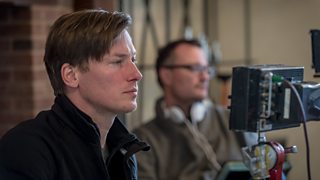Capturing the murky underworld of The Driver
Director of photography David Luther talks about the challenges of The Driver, his creative influences and Manchester's hidden underworld.

It was very important for me to create a world with a stylised realityDavid Luther
What attracted you to this project?
The Driver was an exciting project for me and one that presented plenty of challenges. Not only were there scenes in lots of different locations, there were also plenty of in-car scenes. The director Jamie Payne was very keen to shoot the interior car for real, so the use of low loaders and A-frames were a no-go. The car became the slowest vehicle on the road. It’s not very ‘The Driver’ when delivery trucks overtake you!
Were there any references for you when approaching the project?
was a big inspiration for the interior car treatment. We also used a ‘pod’ car to allow David Morrissey to ‘perform’ his own car chase sequences. The stunt driver sat on top of the car and controlled it from there, which enabled the actor to perform without worrying about the car. In order to accommodate lateral camera movements, sliders were used inside the car. We had an additional small Black Magic 2K camera to enable us to get the lens into places that the Alexa camera could not get to.
I felt that the styles of (photographers) William Eggleston, Nan Golding and Philip-Lorca di Corcia worked well for this show. It was very important for me to create a world with a stylised reality. I wanted to enhance the atmosphere of the scene without it appearing forcefully created.
How did you achieve the look?
The Arri Alexa works well in low light situations. I embraced this and used the natural light available to me to create the ambience. The exterior night scenes were lit by street lights. I disconnected unwanted light sources and then added my own to enhance the ‘urban’ look. I also worked a lot with mercury and sodium lights to achieve the greens, the blues and the browns.
The lights in the car sequences at night were very restricting. We couldn’t rig any lights further from the car than the side mirrors, and had to be careful not to obstruct the driver’s vision or to blind him. Again I chose a higher ‘sensitivity’ of the camera and used small LED sheets which were remote DMX rigged so that I could control them from the car that we followed in. This way I could interact with the outside world and create movement with the lights by dimming them up and down.
The operator, focus puller and actor(s) were in the action car. Director Jamie Payne - with his transmitted monitor - was also with me in the ‘follow’ car and directed from there.
How did you find working in Manchester?
Manchester was inspiring, as it is a very visual city. It has this eclectic mix of the Victorian and the new. There is a strong sense of decay, like the Prague of my student years. You are able to hide in the shadows and the underworld is accepted as a visual part of normal life. The gangster world - which forms the morbid focus of the film – always surrounds the protagonist’s outside world. Manchester and its many textures was therefore the perfect city for this project.
